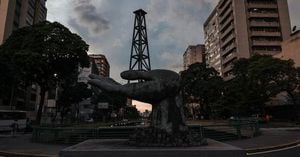Hyderabad, renowned for its rich history and vibrant culture, is currently experiencing exhilarating growth, particularly within its real estate sector. Among six major Indian cities, Hyderabad has been identified as the fastest-growing, boasting impressive infrastructure development and increased real estate demand. This urban metamorphosis is shining through recent reports, particularly the India Prime City Index from Knight Frank India, which reveals significant insights about the city's development.
Over the past decade, Hyderabad has commanded the spotlight with the highest growth rate of 10% Compound Annual Growth Rate (CAGR) for residential property launches. Such rapid expansion positions the city at the forefront of urban development, especially when compared to other key Indian cities like Mumbai, Delhi, and Bengaluru. The vibrant cityscape is redefining housing opportunities, transforming Hyderabad from just another urban center to a burgeoning economic and cultural hub.
According to the report, the economic foundation of Hyderabad isn't just built on technology; it has diversified to encompass sectors such as pharmaceuticals and manufacturing. This broad-based economic engine not only stabilizes the region's growth but also enhances its overall attractiveness for both homebuyers and industries alike. Notably, this diverse economic backdrop significantly contributes to the city’s resilience and long-term growth potential.
Infrastructure, as always, plays a pivotal role. The extensive network of well-planned roads, underpasses, and flyovers have bolstered the connectivity of various neighborhoods. Significant investments from the government, especially projects like the Hyderabad Metro Rail and efforts surrounding outer ring roads, have greatly enhanced the overall urban experience. These developments have made Hyderabad even more appealing to both residents and investors.
A trend observed during this growth phase is the rising demand for luxury homes. With the influx of professionals from various industries, especially the IT sector, the desire for high-end living spaces has surged. This pattern showcases Hyderabad's capability to cater not only to the standard housing market but also to the luxury segment, reflecting the city's overall potential.
While Hyderabad's ascent is commendable, it’s important to observe the challenges other cities face. Alongside its glowing report card, cities like Mumbai, which continues to maintain steady growth across different metrics, especially as India’s financial capital, and Delhi, known for its superior physical infrastructure, still play significant roles within the broader urban narrative. Mumbai's diverse real estate offerings and Delhi's expansive metro system provide competition to Hyderabad’s aspiring growth story.
Bengaluru, with its well-established reputation as the tech capital of India, showcases continuous improvement driven by its dynamic service sector and skilled workforce. The city currently boasts the country's highest workforce participation rate at 76% with minimal unemployment, indicating its strong economic health relative to the other major metropolitan areas.
Despite the senses of optimism surrounding Hyderabad, the recent “Hydra” demolition drives are raising questions about the integrity of the construction sector. These targeted efforts against unauthorized constructions have coincided with scattered reports of stalled real estate projects, leading potential buyers and investors to approach the market with caution. This political turmoil and the regulatory enforcement under the Hyderabad Metropolitan Development Authority (HMDA), introduce new dynamics to the local real estate atmosphere.
HMDA has recently mandated transparency through their latest directive. New regulations require any construction site to display key project information, detailing necessary approvals and ownerships. The intention behind such regulations is to enable smoother inspections and to instill confidence among stakeholders. While lauded as a positive step, the lack of adherence to this mandate raises concerns about enforcement effectiveness.
Implementation challenges have emerged, especially linked to the coordination among relevant departments. Especially problematic is the issuance of No Objection Certificates (NOCs) by the Irrigation Department, which has resulted, at times, in unauthorized constructions being targeted for demolition. This oversight exposes flaws in the verification process, potentially altering buyer confidence negatively.
Buyers find themselves hesitating to invest, fearful of future demolitions or additional legal complications. Meanwhile, developers and builders grapple with increased scrutiny and financial setbacks, leading to project delays. This real estate uncertainty poses significant challenges not just for developers, but for the overall attractiveness of Hyderabad as it aims to be featured prominently on the international urban development stage.
The future of Hyderabad's real estate depends on effective monitoring and enforcement of the policies laid out by HMDA. Regular inspections, strict penalties for non-compliance, and enhanced inter-departmental coordination are necessary for restoring faith among buyers and investors. Transparent communication with stakeholders, especially those directly impacted, can help mitigate concerns and rekindle belief in what has been dubbed as one of India’s promising real estate markets.
Overall, Hyderabad's real estate market stands at the intersection of opportunity and challenge, balancing impressive growth with the everyday realities of urban management. The city's thriving infrastructure and diverse economic portfolio present endless possibilities, but without systematic reforms and cohesive strategies, the burgeoning market risks unraveling. Prospective real estate stakeholders should remain vigilant as they navigate this rapidly changing urban environment. Only time will tell if Hyderabad can continue to buck the trend and emerge as the leading city of choice for future generations.



